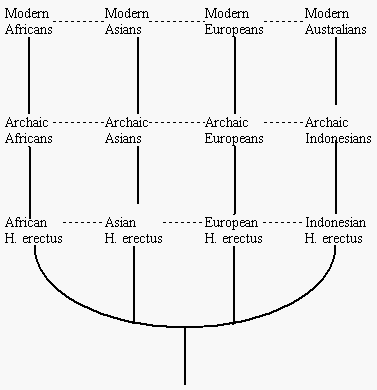Assuming Fraggle’s post 552 with two waves out of Africa is correct I have become interested to know it there is a observable difference in the processes of perception between the relative small number of “first wave” descendents and the majority of humans living now.
As some of you may know, I have a “crackpot” theory of perception which explains a few dozen seemly unrelated facts that the more accepted POV (Perception “emerges” following many stages of neural transformations/ calculation) cannot. Central to my POV is what I call the Real Time Simulation, RTS, which avoid the synaptic delays of the conventional POV.
According to post 552, the first wave was very likely due to the ice age, reduced rain fall, etc. I suggested long ago that the RTS happened in a small in breading group in Africa and gave them a great advantage in conflicts with all other humanoids that did still perceive by the “emergent mechanism.” I.e. ducking a thrown rock or spear is much more successful if your perception of it is in real time, rather than where it was ~0.2 seconds earlier, due to accumulated synaptic diffusion delays. (This also explains why our ancestors killed off the stronger, bigger-brained, Neanderthals etc.)
Does anyone have any information on the perceptual reaction time of the bushmen (the SANs), or the indigent natives of Australia? If it the same as other humans that fact is not destructive of my RTS model of perception but if they are slower to perceive rapid onset events that fact would be additional strong support for the RTS model of perception. The EEG signal called “P300” (or “the startle spike”) should also be reduced in the survivors of the first wave, if the RTS was perfected only by the second wave.
Among the many facts my RTS explains well that are in conflict with the standard “emergent perception” POV are the following eight facts:
(1) The visually perceived / experienced world in front of you is equally sharp and clear for more than 100degree field of perception despite the high resolution retinal data it could “emerge” from comes only from the fovea (less than 2 degrees wide). This experienced clear perception (without blur) does not mean you can read fine text 10 degrees off the point of fixation. (Perception is not the same thing as functional performance.)
(2) The number of neural fibers coming to the “visual cortex” (V1 & V2) from the parietal cortex (where the RTS is created) is actually greater than coming to V1 & V2 from the eyes (via the LGN) – an essential prediction of my RTS model and totally without any rational in the convential “emergent” POV.
(3a) Visual hallucinations completely in conflict with retinal images exist. – What did they “emerge” from?
(3b) Visual dreams and recallable mental images exist and are strongest when the eyes are closed. What did they “emerge” from?
(4a) Parietal strokes often make half the world cease to exist for their victims. Yet in the conventional “emergent” version of perception there is little if any visual processing activity in the parietal cortex.
For more on this, See:
http://en.wikipedia.org/wiki/Unilateral_neglect
(4b) The “startle spike” (EEG P300) is strongest over the parietal cortex. It occurs when something unexpected and significant occurs. I.e. in my RTS, model the extrapolation of neural signals to compensate for the synaptic delays is in conflict with suddenly changed external reality and the RTS must be very briefly paused to re set. The turn on of the RTS again produces the P300 EEG signal.
(4c) The location of the parietal cortex is such as to minimize neural connections (white matter) from and to all of the senses. (optimal neurological arrangement) Visual cortex is adjacent behind it, tactil sensory cortex is immediately in front of it, audio cortex is to the side, and memory, taste/smell are just below. To all these areas (and the LGN) there are “retrograde fibers” which the conventional POV cannot find any need for but I believe take the RTS data back to the earlier available input processing stages so the when revisions of the RTS are needed the conflict (between RTS data & the income sensed data) can be detected at an earlier stage.
(5) To the person with a “phantom limb” his perception of it is just as real and detailed as his perception of his corresponding physical limb. He knows it is not there, but when he is distracted or in a hurry without time to consciously over – rule this perception in his automatic behavior, he behaves as if it is real. For example, one phantom arm extended straight out from the body. When quickly going thru door way etc, he automatically twisted his torso to keep his, perceptually REAL TO HIM, phantom from hitting the door frame. Where did this detailed complex perception "emerge" from? - Smashed and damaged nerve ends? - I don't think so. It came from memory stored body image and was created in the RTS like everything else that is perceived.
Read more about the RTS (including how it can remove the conflict between “free will” and bio-chemistry controlling when every nerve in your brain discharges) at:
http://www.sciforums.com/showpost.php?p=905778&postcount=66
PS, IMHO, the evolution of the RTS is one of the most important evolutionary advances.

